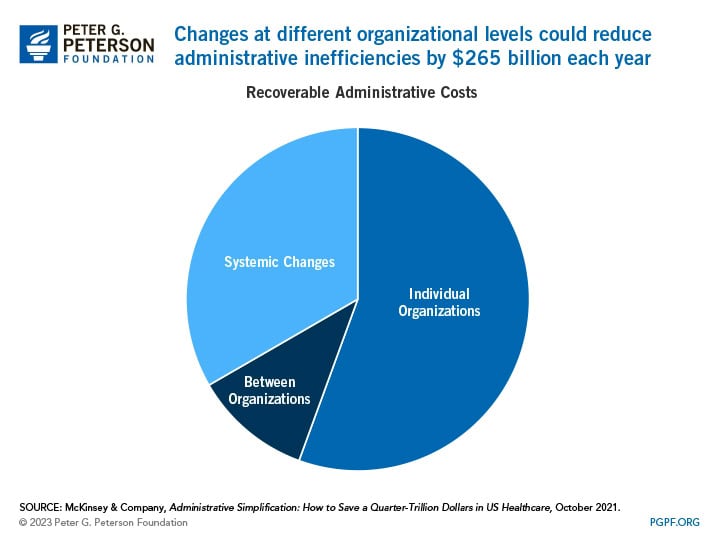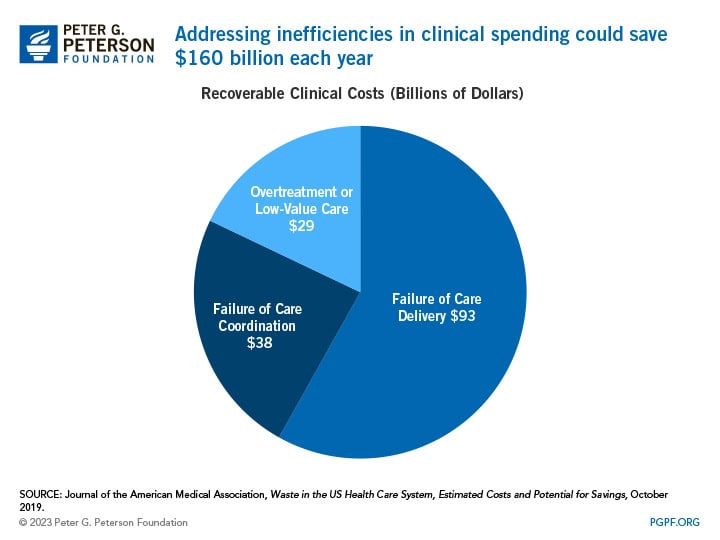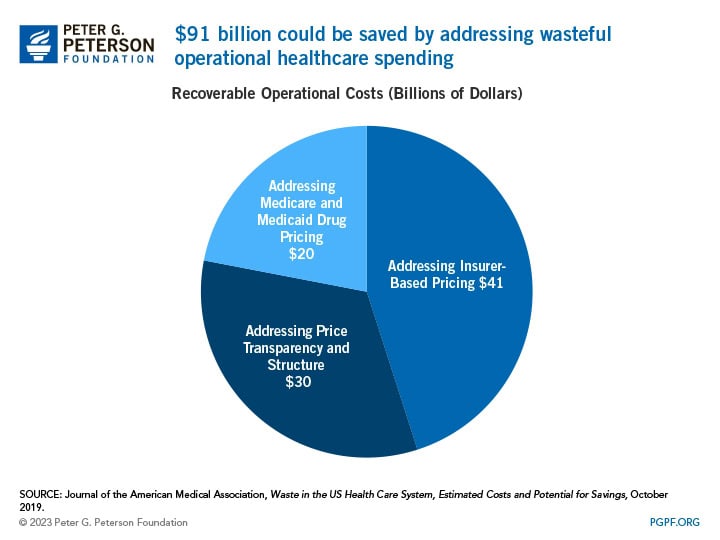It is no secret that the United States spends an exorbitant amount on healthcare — by far the most in the world. In 2021, health spending in the United States totaled $4.3 trillion and averaged nearly $13,000 per person.
It is also well known that despite the huge healthcare spending in the United States, we don’t get what we pay for in terms of outcomes. Many experts point to reducing unnecessary and wasteful healthcare spending to help sustain the budget, economy, and overall wellbeing of the country.
Dr. William Shrank of Humana (a health insurance company) and colleagues estimated that approximately 25 percent of healthcare spending is wasteful. Of that proportion, an estimated $516 billion could be recovered or saved in three main areas: administrative, clinical, and operational. Recent reports from Dr. Shrank and Harvard Professor David Cutler with McKinsey outline solutions in each of those three areas for policymakers to consider when looking for healthcare savings.
Solutions to Reduce Administrative Healthcare Spending
The largest source of spending inefficiencies in U.S. healthcare comes from administrative costs, which are estimated by Shrank to total $351 billion a year. Changes proposed by Cutler and McKinsey & Company could reduce administrative inefficiencies by $265 billion a year (after accounting for $50 billion in overlapping savings across interventions, which is why the estimates below are not fully additive).
- Individual organizations ($175 billion in savings): Small-scale interventions can be implemented by individual organizations. Options include streamlining processes for submitting claims, automating repetitive work in human resources and finance, leveraging new technologies such as analytics and cloud computing, and improving administrative support functions.
- Between organizations ($35 billion in savings): Some solutions would require collaboration between organizations, like using compatible criteria for prior authorization (a process in which a patient’s insurance company reviews the necessity of medical treatment or medication before approving it). Other strategic payer-provider platforms to reduce friction and administrative duplicity would also reduce costs (for example, making it easier to find in-network physicians or the lowest-cost prescription drugs).
- Systemic changes ($105 billion in savings): Hospitals and clinics could adopt a standard automatic clearinghouse to process medical claims that would simultaneously detect fraudulent claims. Other options include standardizing medical policies, physician licensure, and quality of reporting.

Solutions to Reduce Clinical Spending
Shrank and colleagues calculate that inefficient spending on clinical issues costs the United States $345 billion a year. Of that total, they estimate that $160 billion could be saved through the following solutions.
- Addressing failures of care delivery ($93 billion in savings): Options in this category include integration of behavioral and physical health ($58 billion), interventions that address adverse hospital events and hospital-acquired infections ($5 billion), and partnerships for patient campaigns ($3 billion). There is also room to greatly improve prevention initiatives to address ailments such as diabetes, obesity, and smoking ($26 billion).
- Addressing failures of care coordination ($38 billion in savings): Areas of improvement include care coordination in accountable care organizations (ACOs) ($13 billion), transitional care programs, which help facilitate safe discharges home or to other facilities ($9 billion), effective care management for medically complex patients ($8 billion), and emergency department-based strategies, such as video consultations and directing patients to appropriate care with primary care physicians or retail clinics ($7 billion).
- Addressing overtreatment and low-value care ($29 billion in savings): Savings from optimizing the use of medication could save $22 billion annually. Other options include shared decision-making tactics to reduce unnecessary procedures ($3 billion), expanding hospice access ($3 billion), improving prior authorization procedures ($250 million), and pioneering ACO strategies to reduce overuse ($200 million).

Solutions to Reduce Operational Healthcare Spending
Operational issues in healthcare, like pricing failure and excess drug spending, cause an estimated $243 billion in waste each year. Through some reform options proposed by Shrank and colleagues, $91 billion of that waste could be recovered.
- Addressing insurer-based pricing ($41 billion in savings): For the commercially insured, prices for healthcare can vary widely and are typically much higher than those paid by Medicare or Medicaid. Correcting such pricing failures by instituting payment reform to set or limit prices could result in cost savings.
- Addressing price transparency and structure ($30 billion in savings): A study in JAMA found that patients who utilized a pricing website for common medical services were associated with lower claims costs. The savings from that could reduce healthcare costs by almost $30 billion a year. Another recent study from the University of Minnesota assessed the price transparency rules for hospitals and insurers from 2019 and found that such rules could lead to savings of up to $81 billion by 2025.
- Addressing drug utilization and spending ($20 billion in savings): Interventions to address utilization and spending for prescription drugs in Medicare and Medicaid can further reduce spending by $20 billion a year. Reforms involve the ability to create narrower formularies and payment reform for infused products administered in an office or outpatient setting. Reforms addressing drug pricing have gained popularity as a means to reduce operational spending, as the Inflation Reduction Act did by allowing Medicare to negotiate drug prices. That provision is estimated to save $102 billion over the coming decade.

Conclusion
Healthcare costs in the United States are already high and are projected to increase further, posing a serious risk to the economy, the country’s fiscal outlook, and the sustainability of the healthcare system. It is vital that our leaders consider ways to reduce waste and therefore reduce healthcare costs. The solutions to reduce unnecessary spending discussed in this blog offer potential paths forward to save both federal and state governments hundreds of billions of dollars annually.
Image credit: Mario Tama/Getty Images
Further Reading
Quiz: How Much Do You Know About Healthcare in the United States?
The United States has one of the largest and most complex healthcare systems in the world. Take our healthcare quiz to see how much you know about the cost and quality of the U.S. healthcare system.
How Did the One Big Beautiful Bill Act Change Healthcare Policy?
The OBBBA adds significantly to the nation’s debt, but its healthcare provisions lessen that impact by $1.0 trillion.
Infographic: U.S. Healthcare Spending
Improving our healthcare system to deliver better quality care at lower cost is critically important to our nation’s long-term economic and fiscal well-being.


